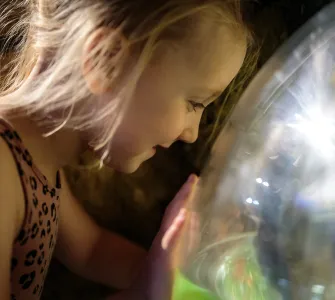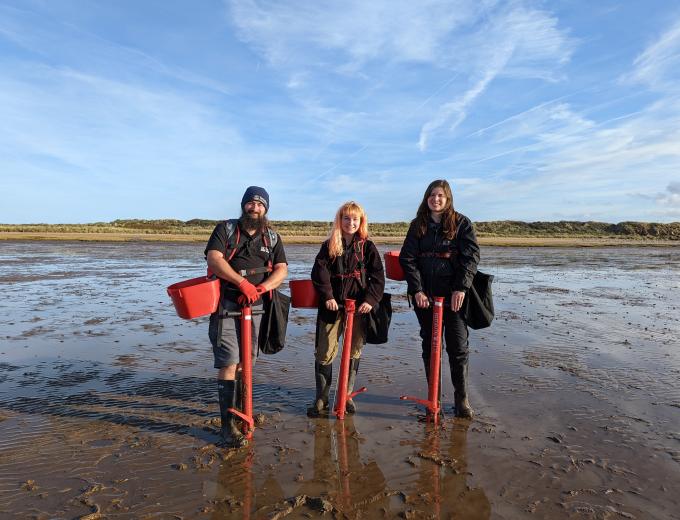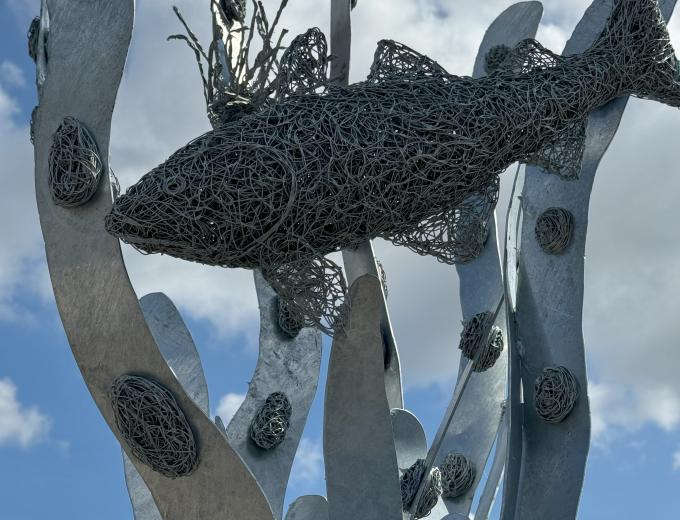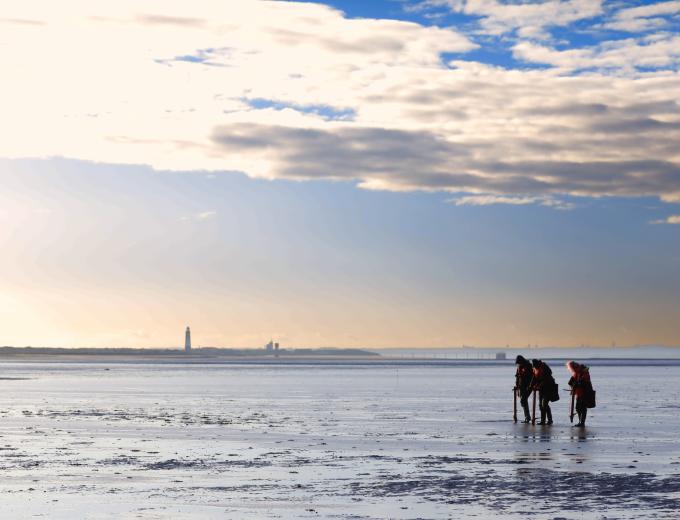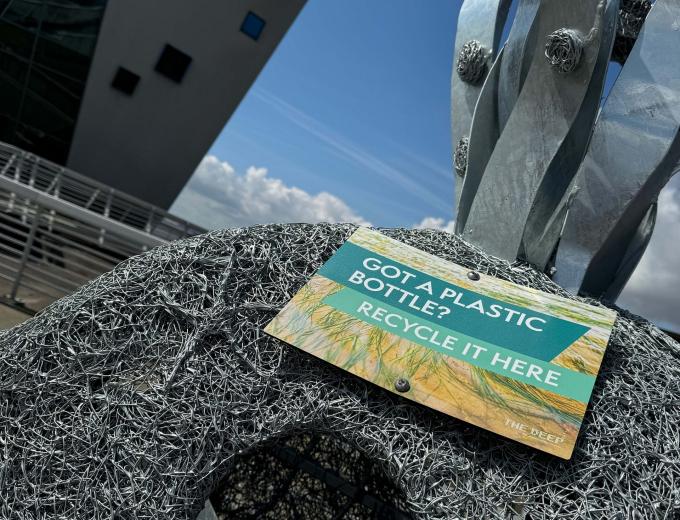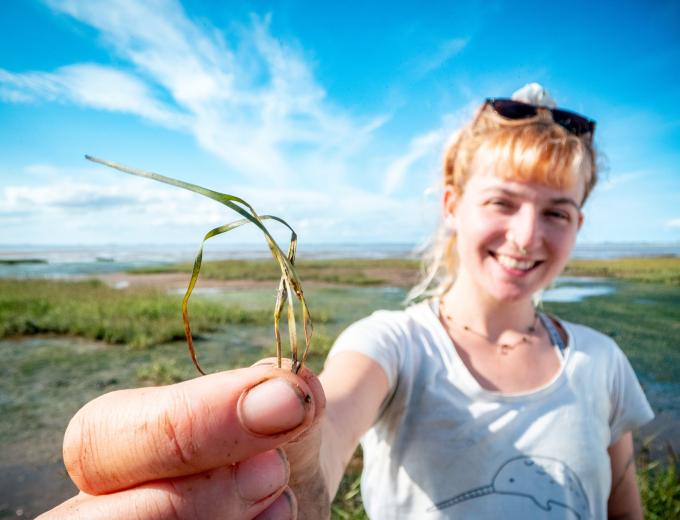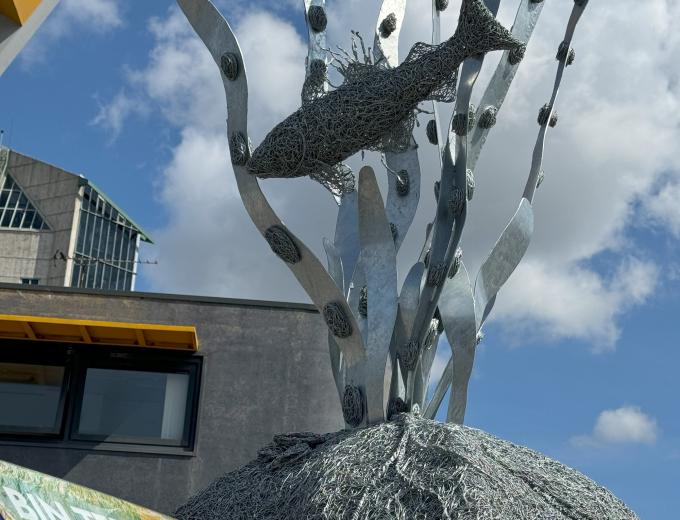An exciting new seagrass sculpture has recently been installed on The Deep’s grounds, funded by Wilder Humber. A pioneering partnership between Ørsted and Yorkshire & Lincolnshire Wildlife Trusts, Wilder Humber has an ambitious 5-year plan: to return 40 hectares of lost biodiversity to the Humber estuary through sand dune, saltmarsh, seagrass, and native oyster restoration. The Deep supports Wilder Humber through exhibition, education and interpretation of this important conservation action.
This beautiful woven sculpture, which also doubles up as a plastic bottle recycling station, is situated beside the popular Millenium footbridge which connects The Deep to Humber Street and other city centre links. It is hoped that many passers-by learn more about seagrass and local conservation action, as well as making use of the recycling station for their plastic bottles.
Martin Slater, Deputy Chief Executive at Yorkshire Wildlife Trust, said:
“Yorkshire Wildlife Trust is delighted to support the installation of the seagrass sculpture and recycling bin at The Deep, as part of our Wilder Humber restoration project.”
“Through the new sculpture, we hope to highlight the importance of healthy seagrass for our marine ecosystems, and raise awareness of seagrass in the Humber estuary both as a valuable habitat for marine species and as an incredible ally in the fight against climate change."
The Humber estuary once supported vast seagrass meadows across both banks, with records of dwarf seagrass covering over 500 hectares at Spurn Point, and vast swathes from Grimsby to Cleethorpes. Due to industrialisation of the estuary, and subsequent decline in water quality, disease and coastal squeeze, the expansive seagrass beds deteriorated almost completely, between the 1930s and 1980s.
Seagrass is the world’s only flowering plant capable of living in seawater and, globally, captures carbon up to 35 times faster than tropical rainforests, accounting for 10-18% of total ocean carbon storage despite covering less than 0.1% of the seafloor. Seagrass can also help protect our coast from damaging storms and erosion through dampening the force of waves and is very effective at removing pollutants from our waters. In the UK, seagrass meadows are a vital habitat for marine life. They support biodiversity by providing essential nursery habitat for important fish species, such as bass and sand eel, and bird species such as Brent geese.
Emma Stothard, the artist behind the seagrass sculpture, was born in Hull but grew up in Kilnsea, a tiny village situated at the northern end of Spurn Point. Emma’s work is often influenced by the wildlife she encountered in the countryside and around the Holderness coastline where she grew up. This particular sculpture represents a native seagrass species, Zostera noltii.
Commenting on the sculpture, she said:
“Creating SEAGRASS for The Deep was a wonderful opportunity to raise awareness and celebrate how important our seagrass meadows are. The sculpture represents the little bags of seeds that are planted in the Humber estuary, which over time grow to create swathes of seagrass meadows that capture carbon and restore vital feeding grounds.”
“We too can help the environment by recycling our plastic bottles in SEAGRASS and at the same time learn a little bit more about this amazing plant.”
Ben Jones, Director of Husbandry & Exhibition, said:
“We are excited to announce the unveiling of the new seagrass sculpture and recycling station on our site, and look forward to seeing plenty of visitors and passers-by alike learning more about the important conservation action that is taking place on our doorstep.”
“Up to 12 million tonnes of plastic waste enters the oceans each year, which has a significant impact on our marine ecosystems. Together, we can work to change this shocking statistic and protect the environment by choosing to reduce the use of single-use plastic.”
Ends
Notes to Editors
Yorkshire Wildlife Trust (www.ywt.org.uk)
Yorkshire Wildlife Trust is the only charity entirely dedicated to conserving, protecting and restoring wildlife and wild places in Yorkshire. Our vision is for a Yorkshire that is abundant in wildlife, with more people having a genuine and meaningful connection with nature. We were established as a charity in 1946 and are part of The Wildlife Trusts movement. We look after over 100 nature reserves right across Yorkshire and are involved in hundreds of other conservation-related projects. Our work inspires people to understand the value of nature and to take action for it.
Wilder Humber (www.wilderhumber.org.uk)
An ambitious five-year programme, ‘Wilder Humber’ is seeking to restore marine habitats and species throughout the Humber estuary.
The programme is delivered through a pioneering conservation partnership between Yorkshire Wildlife Trust, Lincolnshire Wildlife Trust, and international green energy leader Ørsted. It will trial a seascape scale model, combining sand dune, saltmarsh, seagrass, and native oyster restoration to maximise conservation and biodiversity benefits.
The partnership aims to restore and enrich nearly 40 hectares of protected habitats and rebuild the Humber’s lost native oyster population to over half a million. Of the 40 hectares ambition, 30 hectares would focus on restoring lost seagrass meadow at Spurn Point, another key target for Wilder Humber.
Wilder Humber will work with local communities to tell the story of the restoration journey and provide opportunities to contribute to wildlife conservation in the Humber estuary.
• Seagrass meadows are one of the world’s most important and unique habitats. They provide a range of vital solutions aiding the global battle against climate change, contributing to carbon storage, improving water quality, and providing crucial habitat for a number of important marine species.
• However, they are globally under threat and declining, with estimates indicating a loss of 7% of seagrass meadows due to man-made pressures every year.
• 15% of all carbon stores in the ocean are within seagrass meadows, seagrass covers less than 0.1% of the seafloor.
• There are two species of seagrass native to the UK: Zostera marina (Eelgrass) and Zostera noltii (Dwarf eelgrass). Z.noltii occupies the intertidal zone whereas Z.marina is larger and is more typically found subtidally. Zostera noltii is the species the project is restoring at Spurn.
• Seagrasses are marine angiosperms, flowering plants capable of living their entire lives in saltwater.
• Z.noltii shows seasonal changes, with a high proportion of fronds dying off and being removed over winter by herbivore grazing, or storm and wave action. The plant survives as a rhizome over winter and begins to grow new fronds in spring.
• Seagrasses are ecosystem engineers, rhizomes stabilise the sediment by slowing wave action, this can lead to further colonisation of the area by plants such as saltmarsh species.
• Z.noltii can reproduce sexually through the formation of flowers, or asexually through the spreading of rhizomes.
• Seagrass seeds can be transported and survive to germination in the gut of fish mammals and birds.


